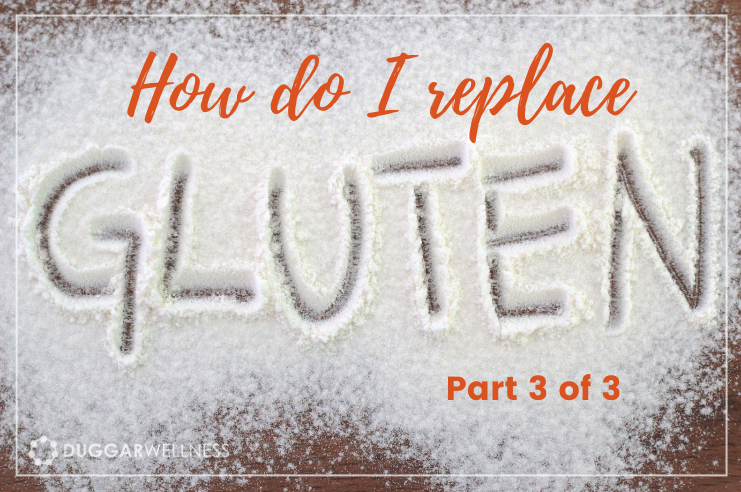Should I avoid gluten? This is a question that I have answered in a 3 part series of posts. Part 1 was titled: Should I Avoid Gluten? Part 2 answered the question: How do I recognize Gluten? This is Part 3 of the series that will help you replace gluten-containing foods and ingredients.
As mentioned in post 2 reading labels at the grocery store can be daunting in the beginning. Trying to replace all gluten-containing foods with a gluten-free alternative can seem even more daunting and expensive.
It really is easiest, to begin with, a basic whole foods diet. Also, it is important to focus on what you CAN EAT rather than dwell on what you can’t eat.
Just a word of advice, it is not uncommon for those with gluten sensitivity or celiac disease to suffer from other food intolerances as well. In fact, studies tell us up to 50% of those with celiac disease or gluten sensitivity also have problems with cow’s milk and other common allergen foods including corn and soy. Keeping a food and symptom journal can help to identify additional sensitivities and symptoms. It is not uncommon for many people to realize that they do much better without any grains at all in their diet during the initial stages of healing.
How strict do I need to be?
Being 100% gluten-free is hard and so everyone wants to have a free pass to “cheat” from time to time. Unfortunately, science isn’t on your side here. Anything less than 100% leaves you open to continued immune assault. A tiny little bit, even in the form of cross-contamination, can do damage if it occurs often enough. The presence of gluten is actually continuing to cause inflammation and preventing your intestines from healing.
One of the best analogies I’ve heard is of comparing damaged intestinal villi to a skinned knee. If you skin your knee, and then keep falling down every couple of days and re-scraping it, it will never heal. Cross-contamination and gluten errors are like falling down and re-scraping your knee. You’ll never get better if you keep falling.
Some people may not react symptomatically to gluten exposures, but that doesn’t mean they aren’t doing any damage. Repeated exposures will keep those antibodies in production and working against you, even if you aren’t noticing any outward symptoms.
The research indicates that it may take 30-60 days for the inflammation to subside and up to 9-12 months for the lining of the small intestine to heal.
Naturally Gluten-Free Foods
Vegetables
Fruits
Nuts, Seeds, Legumes and Beans
Meat, Poultry and Fish
Dairy (if not casein or lactose intolerant)
Many other grains: Quinoa, rice, corn, buckwheat, millet and oats
The Implementation
Cutting out foods that you have spent your whole life eating can sometimes feel like the end of the world, I know, I’ve been there. But guess what? I survived and I continue to survive, in fact, I’m thriving because my body has healed and I no longer suffer from the debilitating symptoms caused by consuming gluten.
The following are secrets that I have learned along the way. These are secrets that I remind myself of often.
Focus first on the foods that are naturally gluten-free.
There is so much bounty in our world! So many varieties of fruits and vegetables, nuts and seeds, legumes, and meat, poultry, and fish.
Have a sense of adventure.
My kitchen is my playground; a place where I can create and explore. Don’t let life get so crazy-busy that you don’t take time to play in your kitchen.
If you’ve never played in your kitchen, now is a great time to start!
When making a new recipe, make it a few times as written, and then the next time experiment with different ingredients and see what works best for you. My recipes are mine because I like how they taste and so do the people in my home. Don’t be afraid to tweak a recipe based on your own taste preferences. (By the way, all recipes on this site are gluten-free.)
Accept your situation.
Instead of constantly bemoaning the fact that you cannot buy and eat anything that you want at the grocery store or off the menu at a restaurant, remember this is an opportunity to learn, grow and explore the endless possibilities that food provides. Everything will be easier if you live with this attitude.
You’ll adapt.
When you start trying gluten-free products or baking on your own it won’t taste like the food you once ate. With time, however, your taste buds will change and you will develop a relationship with new foods and all of their textures and tastes.
Above all, remember that food is essential, food is nourishing, and food is beautiful. Enjoy the journey!
Gluten-Free Flour Guide
For help with your journey check out this amazing Gluten-Free Flour Guide.
The world of gluten-free baking is both wonderful and challenging. I’ve experienced incredibly delicious outcomes and disappointing results when baking gluten-free. Using this A to Z gluten-free flour guide, you can skip the flops and rock-hard gluten-free muffins and go straight to the scrumptiousness.
 160 N Main, Bountiful, UT 84010
160 N Main, Bountiful, UT 84010  801-677-7878
801-677-7878

2 responses to “How do I replace gluten? Part 3 of 3”
[…] Do you want to continue reading and learning about gluten? See Part 2: How do I recognize gluten? and Part 3: How do I replace gluten? […]
[…] Keep a list of gluten containing ingredients with you. Make a list on your phone or tucked into your wallet so that you can use it as a reference when shopping until you easily remember what to look for on ingredient lists. For some real life strategies check out the post titled: How do I replace gluten? […]